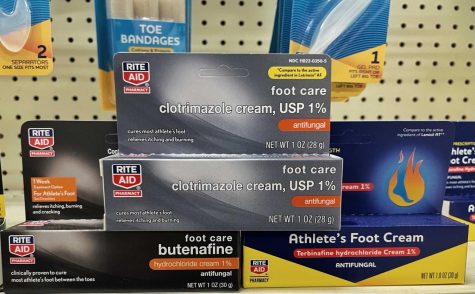The Pitt Prescription | Self-care for superficial fungal infections
The Pitt Prescription is a biweekly blog where student pharmacist and senior staff writer Elizabeth Donnelly provides tips on how to stay healthy in college. This edition was reviewed by Karen Pater, PharmD., CDCES, BCACP.
Shruti Talekar | Contributing Editor
The Pitt Prescription
November 11, 2021
We are currently at that time of the year where the mornings are freezing, but by the afternoon, the weather is much warmer. If you’re dressed for the frigid morning, it’s likely you’ll be sweating later in the day, and sweat is a breeding ground for several kinds of infections, most likely fungal.
Fungal infections – otherwise known as mycoses – are the most common form of infection, with roughly 20 to 25% of the world being infected with a superficial fungal infection at any time. Fungal infections may fall into two categories — superficial or deep mycoses. Superficial mycoses are infections that are present on the surface of the skin, hair and/or nails, whereas deep mycoses are infections that penetrate deeper than the surface or spread systemically throughout the body.
Some of the most common kinds of fungal infections include athlete’s foot, ringworm, jock itch and nail fungus which are all considered superficial mycoses. Yeast infections are another kind of non-serious fungal infection seen commonly in the college-aged population. These infections are fairly unique in that even otherwise fully healthy individuals could be infected with a fungus, and fungal infection is not dependent on a predisposing condition. But there are some conditions that may increase the risk of being infected with a fungus, including people with weakened immune systems due to things like HIV, cancer, organ transplant or hospitalization.
According to the Handbook of Nonprescription Drugs, there are several treatment options for each of these fungal infections, including non-pharmacologic actions. The main goals of self-care are to relieve discomfort, inhibit the growth of fungi and to prevent any further recurring infections from happening. Many of these OTC antifungals come in creams, sprays and powders, but the creams are often the most efficacious non-prescription therapy.
Athlete’s foot (tinea pedis)
Athlete’s foot is the most common fungal skin infection, and it typically appears in between the toes and may spread to other parts of the foot. It is commonly spread through contact with fungi in a damp area like in locker rooms or swimming pools, and heat and moisture increase its growth. This condition is highly contagious and presents as an itchy, scaly rash between the toes and/or on the foot.
Recommendations for self-care treatments include:
- Miconazole 2% or clotrimazole 1% – apply twice daily to affected area for four weeks
- Butenafine 1% – apply twice daily for one week or once daily for four weeks for athlete’s foot in-between the toes
- Terbinafine 1% – apply twice daily for one week if infection is between the toes or twice daily for two weeks if infection is on the bottom or sides of the foot
- Tolnaftate 1% – apply daily for four weeks (this medication is the only OTC approved for treatment and prevention of athlete’s foot)

Ringworm (tinea corporis)
Ringworm can appear anywhere on the body and it is most common in younger individuals. It’s often spread through contact with another infected individual or if the fungus comes into contact with broken skin. This infection is also common in damp or moist areas, like locker rooms. This condition is also highly contagious and it typically presents as a circular or ring-shaped rash and may be red, itchy, scaly or cracked.
Recommendations for self-care treatments include:
- Miconazole 2% or clotrimazole 1% – apply twice daily to affected skin for four weeks
- Butenafine 1% – apply once daily to affected skin for two weeks
- Terbinafine 1% – apply once daily to affected skin for one week
- Tolnaftate 1% – apply daily for four weeks
Jock itch (tinea cruris)
Jock itch, also known as “ringworm of the groin,” is most common in adult men and typically appears on the upper thighs and pubic area. This condition often occurs if the groin area is wet for a long period of time and is exposed to fungus. This infection is also contagious and it usually appears as scaly, itchy red blotches on the inner thighs and in skin folds.
Recommendations for self-care treatments include:
- Miconazole 2% or clotrimazole 1% – apply twice daily to affected skin for two weeks
- Butenafine 1% – apply once daily to affected skin for two weeks
- Terbinafine 1% – apply once daily to affected skin for one week
- Tolnaftate 1% – apply daily for two weeks
“Onychomycosis” nail fungus (tinea unguium)
Nail fungus is typically associated with Athlete’s foot, but it can present by itself as well. This infection often causes the affected nails to become thick, discolored and more easily breakable. Onychomycosis is more commonly seen in toenails than fingernails, however both are possible. This infection may form when small cracks in the nail or surrounding skin come into contact with fungi. Although onychomycosis may be contagious, person-to-person spread is not very common.
It is not recommended to treat onychomycosis using self-care, even though there are OTC products available for purchase. Instead, you should see a health care provider if you suspect you have a fungal infection in your nails. The most commonly recommended treatment for this is oral terbinafine, not topical, which requires a prescription and doctor monitoring.
There are also several non-pharmacologic options to assist with the above fungal infections. You should always use a separate towel to dry the infected area(s) so as to not spread it to other parts of the body. Additionally, do not share any towels, clothing or shoes while actively infected. Wash any contaminated items (towels, clothes, etc.) separately from non-contaminated items. Cleanse the affected areas daily and make sure to dry well, avoiding anything that may keep the area moist or wet for long periods of time. Finally, make sure to wear protective footwear in any communal areas, like locker rooms or shared dorm showers, to avoid picking up fungi. Ensure these shoes are dry before further uses.
Vaginal yeast infection (candidiasis)
Yeast infections are another common fungal infection, usually seen in adult women. A type of fungus called Candida causes this infection. Yeast infections form if there is an overgrowth of Candida and women taking antibiotics, using hormonal contraceptives (like birth control pills) or with underlying health conditions like diabetes have an increased risk. These infections typically present with abnormal vaginal discharge, itching, soreness, pain during urination and pain during sex. Most yeast infections are typically not contagious, but they can be quite bothersome and uncomfortable. Sometimes they may present with similar symptoms to STIs, so if you’re ever in doubt, you should see a doctor.
Recommendations for self-care treatments include:
- Clotrimazole 1% or miconazole 2% (Monistat 7 Cream) cream – insert into the vagina daily for seven days and apply to the vulva as needed (up to twice daily) for itching
- Miconazole 2% cream + miconazole 1200mg suppository (Monistat 1-Day Treatment) – apply the cream to the vulva as needed (up to twice daily) for itching and insert one suppository into the vagina
- Tioconazole 6.5% (Vagistat-1) – insert ointment into the vagina once
While it’s possible to resolve many fungal infections with OTC products, if you have recurring infections or are immunocompromised, you should see a health care provider to make sure there isn’t anything more serious going on. Additionally, it is important to see a health care provider if the products above do not work in their allotted duration. You should not use these OTC products longer than what is indicated on their labels without direct instructions from a doctor.
Finally, always remember that your local pharmacist is able to help you choose the best self-care options for your individual situation, so don’t hesitate to ask questions when choosing OTC products.
Elizabeth writes primarily about self-care and pharmacological topics. For questions, comments or concerns, you can reach her at ead85@pitt.edu.




